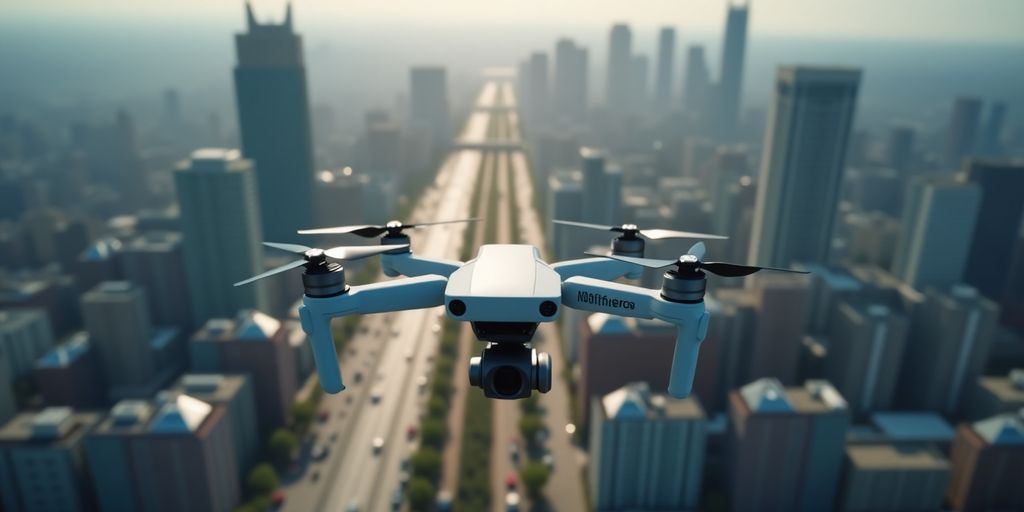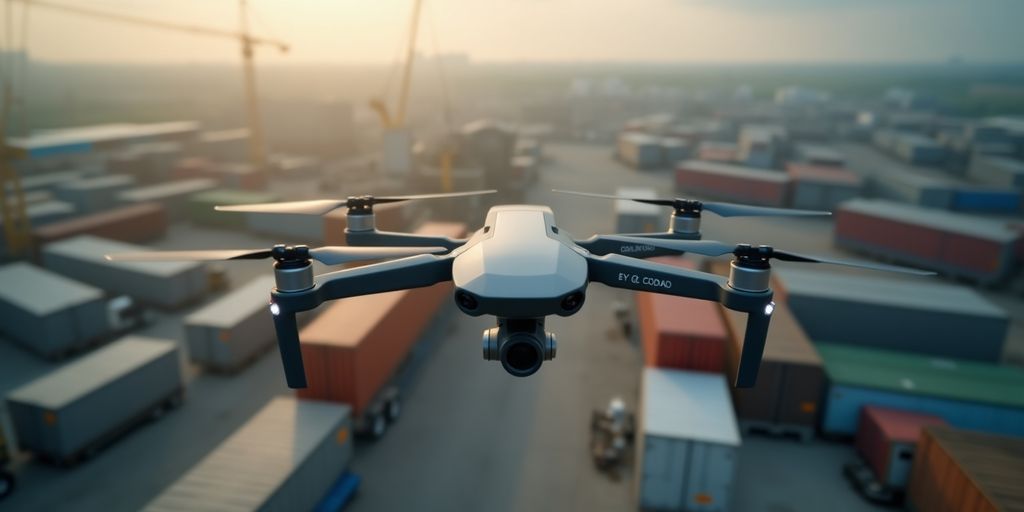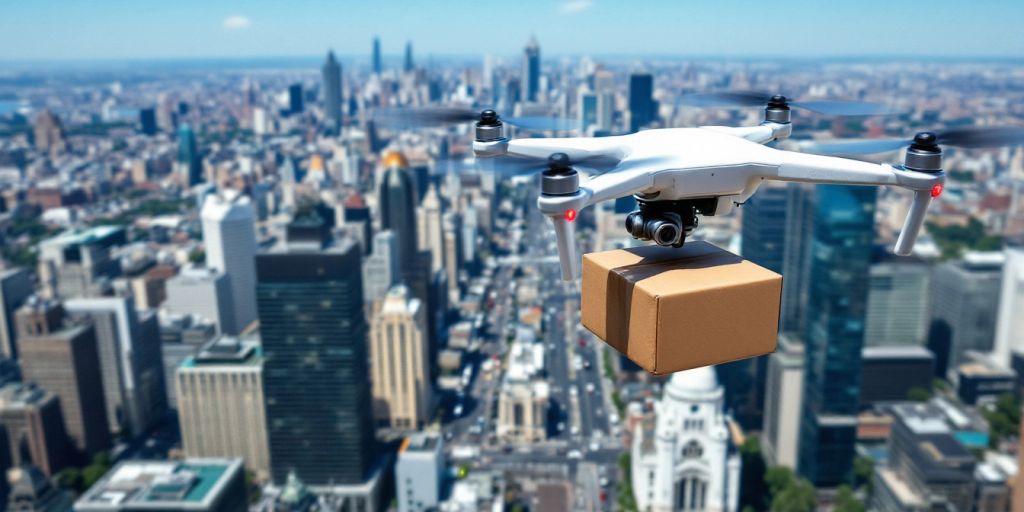Importance of drones in business operations
Drones are changing how businesses operate. These flying machines are not just for fun; they are powerful tools that help companies work better, faster, and safer. Drones are making a big difference in many industries, from delivering packages to inspecting buildings. This article explores how drones in business operations boost efficiency and what the future holds for this exciting technology.
Drones in Business Operations: Key Takeaways
- Drones are becoming essential tools in various industries, improving efficiency and accuracy.
- They help companies save money by reducing labor costs and speeding up processes.
- Drones can collect valuable data that supports better decision-making and project planning.
- Safety is enhanced as drones can perform tasks in dangerous areas without putting workers at risk.
- The future of drones in business looks bright with ongoing advancements in technology and applications.
The Rise of Commercial Drones

Definition and Types of Commercial Drones
Commercial drones are unmanned aerial vehicles (UAVs) for various business purposes. They come in different types, including:
- Fixed-wing drones: Ideal for long-distance flights and covering large areas.
- Multi-rotor drones: Best for short flights and precise maneuvers, often used in photography and inspections.
- Hybrid drones: Combine features of both fixed-wing and multi-rotor drones, offering versatility.
Drone Market Size and Growth Potential
The commercial drone market is rapidly expanding. In 2022, it was valued at nearly $20 billion, with a projected growth rate of 13.9% annually through 2030. Increasing applications in various industries, including agriculture, construction, and logistics drive this growth.
| Year | Market Size (in billion $) | Growth Rate (%) |
|---|---|---|
| 2022 | 20 | – |
| 2023 | 22.7 | 13.9 |
| 2030 | 40 | 13.9 |
Federal Aviation Administration (FAA) Regulations and Compliance
The FAA plays a crucial role in regulating commercial drone operations. Recent changes allow drones to fly over people at night, providing safety measures are in place. Compliance with these regulations is essential for businesses to operate drones legally and safely.
Integrating drones into business operations is not just about technology; it’s about enhancing efficiency and transforming how industries function.
In summary, the rise of commercial drones is marked by their diverse types, significant market growth, and the importance of adhering to FAA regulations. As businesses continue to explore innovative uses for drones, their impact on efficiency and productivity will only increase.
Drone Technology and Applications

Drone Delivery and Logistics: Revolutionizing Supply Chains
Delivery drones are changing how businesses deliver products. Drone delivery services, such as those initiated by Amazon since 2013, are advancing rapidly. They can quickly transport items, making deliveries faster and more efficient. This technology is revolutionizing businesses with drones by cutting down delivery times and costs. For example, companies can use drones to deliver packages directly to customers’ homes, reducing the need for delivery trucks.
Infrastructure Inspection and Maintenance with Drone Technology
Drones are also used for inspecting buildings and infrastructure. They can reach high places and gather data without putting workers at risk. This method is not only safer but also saves time and money. Here are some benefits of using drones for inspections:
- Faster data collection
- Reduced labor costs
- Improved safety for workers
Aerial Photography and LiDAR for Mapping and Surveying
Drone photography and LiDAR technology are used for mapping and surveying land. Aerial footage provides a unique perspective that is often unavailable from ground level, offering advantages over traditional methods that were costly and complex. They can create detailed maps and 3D models, which are useful for various industries. This technology allows for:
- Accurate land measurements
- Efficient data collection
- Enhanced project planning
Drones can autonomously clean windows on tall buildings, while IoT-enabled systems can monitor drone operations and track performance metrics. In summary, drone technology is making significant impacts across various sectors, enhancing efficiency and safety in business operations.
Business Benefits of Drone Adoption
Increased Efficiency and Productivity with Commercial Drones
Drones are changing the way businesses operate by significantly boosting efficiency. Drone data provides detailed insights into various aspects, such as crop health, soil conditions, and resource management, allowing companies to make informed decisions and improve productivity. They can perform tasks faster than traditional methods, allowing companies to complete projects in less time. For instance:
- Drones can cover large areas quickly, making inspections and surveys much faster.
- They can operate in hard-to-reach places without the need for scaffolding or ladders.
- Automated drone deliveries can reduce wait times for customers.
Overall, the integration of drones leads to a more streamlined workflow.
Cost Savings and Reduced Labor Costs
Using drones can lead to substantial cost savings for businesses. Here are some key points:
- Drones reduce the need for manual labor, which can lower payroll expenses.
- They minimize the risk of costly project delays by providing real-time data.
- Drones can help in resource management, reducing material waste.
In many cases, the initial investment in drone technology pays off quickly through these savings.
Improved Safety and Risk Management
Drones enhance safety in various industries by:
- Performing dangerous tasks, such as inspections of high structures, without putting human workers at risk.
- Providing real-time data can help identify potential hazards before they become serious issues.
- Reducing the need for workers to operate in hazardous environments.
Drones not only improve operational efficiency but also contribute to a safer workplace.
In conclusion, adopting drones in business operations is a game-changer, leading to increased efficiency, cost savings, and improved safety. As companies continue exploring these benefits, drones’ potential to transform various industries is immense. For more information on how to enhance your business operations through automation, robotics, and drone solutions, we invite you to reach out to experts in the field.
Industry-Specific Use Cases

Agriculture and Precision Farming with Drones
Drones are changing the way farmers work. They help in monitoring crops, assessing health, and even spraying pesticides. Drones can access remote locations, gathering essential data from difficult-to-reach ecosystems. This technology allows farmers to be more efficient and precise. Some key benefits include:
- Real-time data collection
- Reduced labor costs
- Improved crop yields
Construction and Real Estate: Leveraging Drone Technology
In construction, drones are used for site surveys and inspections. They provide high-quality images and data that help in planning and monitoring projects. Drones can save time and money in construction projects. Here are some uses:
- Aerial site surveys
- Progress tracking
- Safety inspections
Emergency Response and Disaster Management with Drones
Drones play a crucial role in emergencies. In the event of natural disasters, drones can quickly assess damage and locate victims, significantly enhancing emergency response capabilities. They can quickly assess damage and help in search and rescue operations. Their speed and efficiency can save lives. Some applications include:
- Delivering supplies to hard-to-reach areas
- Mapping disaster zones
- Monitoring wildfires
Case Studies from Lucid Bots
Lucid Bots has successfully implemented drone technology in various sectors. Their innovative solutions have shown how drones can enhance operations and improve outcomes. The results speak for themselves.
Drones are not just a trend; they are becoming essential tools in many industries, driving efficiency and effectiveness in ways we never imagined.
Overcoming Challenges and Limitations
Safety Issues and Government Regulation
Drones are becoming more common in business, but there are still safety concerns and rules that must be followed. Companies need to ensure that their drones operate safely and comply with regulations set by the Federal Aviation Administration (FAA). This includes getting the right licenses and training for operators.
Public Perception and Acceptance
Many people are still unsure about drones. Some worry about privacy and safety. To overcome this, businesses should focus on educating the public about the benefits of drones. This can help build trust and acceptance in the community.
Cybersecurity and Data Protection
As drones collect and transmit data, they can be targets for hackers. Companies must invest in strong cybersecurity measures to protect sensitive information. This includes using encryption and secure networks to keep data safe.
Drones can greatly improve efficiency, but businesses must address these challenges to fully benefit from their use.
Summary of Challenges
- Safety Issues: Ensuring safe operation and compliance with regulations.
- Public Perception: Educating the public to gain acceptance.
- Cybersecurity: Protecting data from potential threats.
By tackling these challenges, businesses can unlock the full potential of drone technology in their operations.
Real-World Examples and Success Stories
Companies Using Drones for Innovative Solutions
Many businesses are now using drones to improve their operations. The commercial drone use has a significant economic impact, creating job opportunities and increasing efficiency across various industries. Here are some examples:
- Amazon: They are testing drone delivery to get packages to customers faster.
- Walmart: Uses drones for inventory management in their warehouses.
- BP: Employs drones for inspecting oil rigs, which helps in reducing costs and improving safety.
Organizations Leveraging Drones for Environmental Conservation
Drones are also making a difference in environmental efforts. Drone services are increasingly used in environmental monitoring and conservation, providing valuable data for tracking changes in ecosystems and wildlife. Some notable uses include:
- Wildlife Monitoring: Organizations use drones to track animal populations and their habitats.
- Forest Management: Drones help in assessing forest health and planning conservation efforts.
- Pollution Tracking: Drones can monitor air and water quality in hard-to-reach areas.
Drones are transforming how businesses operate, making processes faster and safer. In summary, the use of drones in various sectors is not just a trend; it is a significant shift towards more efficient and effective operations. As companies like Amazon and Walmart show, the potential for innovation is vast, and the benefits are clear.
| Company | Use of Drones | Benefits |
|---|---|---|
| Amazon | Delivery | Faster service |
| Walmart | Inventory | Cost savings |
| BP | Inspections | Improved safety |
The Future of Drone Integration

Advancements in Artificial Intelligence and Autonomous Drones
The future of drones is closely tied to advancements in artificial intelligence (AI). Drone pilots currently play a crucial role in setting flight paths for drones, enabling these devices to autonomously carry out tasks and gather data. As AI technology improves, drones will become more autonomous, allowing them to perform complex tasks without human intervention. This will lead to increased efficiency in various industries. For example, drones could autonomously inspect infrastructure, monitor crops, or deliver packages, significantly reducing the need for manual labor.
Integration with Other Technologies and Systems
Drones are not just standalone devices; they can be integrated with other technologies to enhance their capabilities. This includes:
- IoT (Internet of Things): Drones can collect data from various sensors and devices, providing real-time insights.
- Cloud Computing: Storing and processing data in the cloud allows for better data management and analysis.
- Machine Learning: Drones can learn from past data to improve their performance over time.
Predictions for Future Trends and Growth
The drone industry is expected to grow rapidly in the coming years. Here are some key predictions:
- Increased Adoption: More businesses will adopt drones for various applications, from delivery to surveillance.
- Regulatory Changes: Governments will likely create more regulations to ensure safe drone operations in shared airspace.
- Technological Innovations: Continuous advancements in drone technology will lead to new applications and improved efficiency.
The integration of drones into everyday business operations is not just a trend; it is a revolution that will change how industries operate.
In summary, the future of drone integration looks bright, with advancements in AI, technology integration, and significant growth expected across various sectors. Drones will play a crucial role in enhancing efficiency and productivity in business operations.
Conclusion and Key Takeaways
In conclusion, the integration of drones into business operations is transforming how companies function. Drones are not just a trend; they are a game-changer. Here are some key takeaways:
Summary of the Benefits and Future of Drones in Business
- Increased Efficiency: Drones streamline processes, allowing for faster data collection and analysis.
- Cost Savings: By reducing labor costs and minimizing errors, drones can lead to significant financial savings.
- Enhanced Safety: Drones can perform dangerous tasks, reducing the risk to human workers.
The future of drones looks bright, with advancements in technology promising even more innovative applications. As businesses continue to adopt drone technology, they will likely see improvements in productivity and operational resilience, making them more competitive in their respective markets.
The potential of drones in business is vast, and as technology evolves, so will the ways in which we utilize these tools for efficiency and growth.
Overall, embracing drone technology can lead to a revolutionary shift in how businesses operate, paving the way for a more efficient and effective future.
Conclusion
In conclusion, drones are changing the way businesses operate, making them more efficient and effective. By using drones, companies can save time and money while improving safety and productivity. Drones help in gathering important data quickly, which allows businesses to make better decisions. They also reduce the need for workers to go into dangerous areas, keeping everyone safer. As technology continues to improve, we can expect drones to play an even bigger role in various industries. Embracing this technology can lead to a brighter future for businesses, helping them to grow and succeed.
Frequently Asked Questions
What are commercial drones used for?
Commercial drones are used in various industries like delivery, construction, agriculture, and inspection. They can help with tasks such as transporting goods, monitoring crops, and inspecting buildings.
How do drones improve business efficiency?
Drones help businesses save time and money by automating tasks that usually require human labor. They can collect data quickly and accurately, allowing companies to make better decisions.
Are there regulations for using drones in business?
Yes, there are regulations set by the Federal Aviation Administration (FAA) that businesses must follow when using drones. These rules ensure safety and proper use of drones in the airspace.
What are the benefits of using drones in agriculture?
Drones in agriculture help farmers monitor crop health, manage resources more effectively, and increase yields. They can cover large areas quickly, providing valuable data for better farming decisions.
Can drones be used for emergency response?
Yes, drones can assist in emergency situations by providing real-time information, surveying disaster areas, and helping with search and rescue operations. They can reach places that are hard for people to access.
What challenges do businesses face when adopting drone technology?
Some challenges include safety concerns, public acceptance, and the need for proper training. Businesses also need to invest in technology and ensure compliance with regulations.


